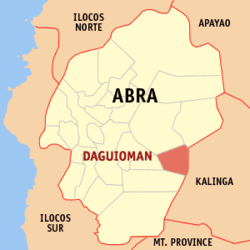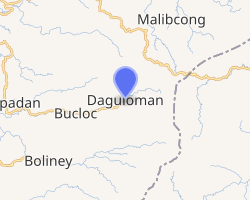Daguioman
Daguioman, officially the Municipality of Daguioman (Ilocano: Ili ti Daguioman; Tagalog: Bayan ng Daguioman), is a 5th class municipality in the province of Abra, Philippines. According to the 2015 census, it had a population of 2,088 people.[3]
Daguioman | |
|---|---|
| Municipality of Daguioman | |
 Seal | |
 Map of Abra with Daguioman highlighted | |
OpenStreetMap 
| |
.svg.png) Daguioman Location within the Philippines | |
| Coordinates: 17°28′N 120°56′E | |
| Country | |
| Region | Cordillera Administrative Region (CAR) |
| Province | Abra |
| District | Lone District |
| Barangays | 4 (see Barangays) |
| Government | |
| • Type | Sangguniang Bayan |
| • Mayor | Marcelo J. Padilla |
| • Vice Mayor | Salma Q. Padilla |
| • Congressman | Joseph Santo Niño B. Bernos |
| • Electorate | 1,391 voters (2019) |
| Area | |
| • Total | 114.37 km2 (44.16 sq mi) |
| Population (2015 census)[3] | |
| • Total | 2,088 |
| • Density | 18/km2 (47/sq mi) |
| • Households | 375 |
| Economy | |
| • Income class | 5th municipal income class |
| • Poverty incidence | 30.34% (2015)[4] |
| • Revenue (₱) | 51,091,356.58 (2016) |
| Time zone | UTC+8 (PST) |
| ZIP code | 2816 |
| PSGC | |
| IDD : area code | +63 (0)74 |
| Climate type | tropical rainforest climate |
| Native languages | Itneg language Ilocano Tagalog |
Geography
According to the Philippine Statistics Authority, the municipality has a land area of 114.37 square kilometres (44.16 sq mi) [2] constituting 2.75% of the 4,165.25-square-kilometre- (1,608.21 sq mi) total area of Abra.
Barangays
Daguioman is politically subdivided into 4 barangays.[5]
| PSGC | Barangay | Population | ±% p.a. | |||
|---|---|---|---|---|---|---|
| 2015[3] | 2010[6] | |||||
| 140105001 | Ableg | 10.2% | 213 | 175 | 3.81% | |
| 140105002 | Cabaruyan | 23.9% | 500 | 412 | 3.75% | |
| 140105003 | Pikek | 19.6% | 410 | 313 | 5.27% | |
| 140105004 | Tui (Poblacion) | 46.2% | 965 | 815 | 3.27% | |
| Total | 2,088 | 1,715 | 3.82% | |||
Climate
| Climate data for Daguioman, Abra | |||||||||||||
|---|---|---|---|---|---|---|---|---|---|---|---|---|---|
| Month | Jan | Feb | Mar | Apr | May | Jun | Jul | Aug | Sep | Oct | Nov | Dec | Year |
| Average high °C (°F) | 25 (77) |
26 (79) |
28 (82) |
30 (86) |
29 (84) |
29 (84) |
28 (82) |
28 (82) |
28 (82) |
27 (81) |
27 (81) |
25 (77) |
28 (81) |
| Average low °C (°F) | 18 (64) |
18 (64) |
19 (66) |
21 (70) |
22 (72) |
23 (73) |
23 (73) |
23 (73) |
22 (72) |
21 (70) |
20 (68) |
19 (66) |
21 (69) |
| Average precipitation mm (inches) | 23 (0.9) |
28 (1.1) |
33 (1.3) |
64 (2.5) |
232 (9.1) |
242 (9.5) |
258 (10.2) |
266 (10.5) |
245 (9.6) |
201 (7.9) |
87 (3.4) |
69 (2.7) |
1,748 (68.7) |
| Average rainy days | 8.3 | 8.0 | 10.8 | 15.2 | 23.7 | 26.1 | 27.0 | 25.8 | 23.5 | 17.3 | 13.7 | 12.1 | 211.5 |
| Source: Meteoblue (modeled/calculated data, not measured locally) [7] | |||||||||||||
Demographics
| Year | Pop. | ±% p.a. |
|---|---|---|
| 1939 | 596 | — |
| 1948 | 666 | +1.24% |
| 1960 | 1,003 | +3.47% |
| 1970 | 1,050 | +0.46% |
| 1975 | 1,124 | +1.38% |
| 1980 | 1,254 | +2.21% |
| 1990 | 1,413 | +1.20% |
| 1995 | 1,475 | +0.81% |
| 2000 | 1,748 | +3.71% |
| 2007 | 1,916 | +1.27% |
| 2010 | 1,715 | −3.95% |
| 2015 | 2,088 | +3.82% |
| Source: Philippine Statistics Authority[3][6][8][9] | ||
In the 2015 census, Daguioman had a population of 2,088.[3] The population density was 18 inhabitants per square kilometre (47/sq mi). Daguioman is the home of the Banao tribe of Itneg.
gollark: GEORGE pulls all strings.
gollark: Play Minoteaur 7.2.
gollark: I assumed that it just emerged fully formed from the void.
gollark: We also have dedicated GEORGE (sub)fora.
gollark: Technically, GEORGE was invented, discovered and assembled.
References
- "Municipality". Quezon City, Philippines: Department of the Interior and Local Government. Retrieved 31 May 2013.
- "Province: Abra". PSGC Interactive. Quezon City, Philippines: Philippine Statistics Authority. Retrieved 12 November 2016.
- Census of Population (2015). "Cordillera Administrative Region (CAR)". Total Population by Province, City, Municipality and Barangay. PSA. Retrieved 20 June 2016.
- "PSA releases the 2015 Municipal and City Level Poverty Estimates". Quezon City, Philippines. Retrieved 12 October 2019.
- "Municipal: Daguioman". PSGC Interactive. Quezon City, Philippines: Philippine Statistics Authority. Retrieved 8 January 2016.
- Census of Population and Housing (2010). "Cordillera Administrative Region (CAR)". Total Population by Province, City, Municipality and Barangay. NSO. Retrieved 29 June 2016.
- "Daguioman: Average Temperatures and Rainfall". Meteoblue. Retrieved 25 April 2020.
- Censuses of Population (1903–2007). "Cordillera Administrative Region (CAR)". Table 1. Population Enumerated in Various Censuses by Province/Highly Urbanized City: 1903 to 2007. NSO.
- "Province of Abra". Municipality Population Data. Local Water Utilities Administration Research Division. Retrieved 17 December 2016.
This article is issued from Wikipedia. The text is licensed under Creative Commons - Attribution - Sharealike. Additional terms may apply for the media files.